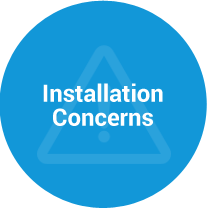Innovating Our Solutions and Our Website. As we introduce new solutions to better meet your needs, we’re also rolling out a new and improved website. Thank you for your patience during this time.
Epoxy Lining is a general term for a variety of different plastic resins used on hot and cold water supply pipes, sprinkler lines, HVAC piping, gas lines and certain drain, waste and vent piping. The National Sanitation Foundation (NSF) and U.S. Environmental Protection Agency (EPA) have certified some epoxy linings for carrying potable drinking water. Epoxy resins are generally not certified as a “structural improvement” to the existing piping system.
Click on the icons below to read more about the concerns and challenges of epoxy pipe lining.
Possible Installation Concerns
Installation Contractor Quality Control
Our observations/conclusions and the literature indicate that the most common vulnerabilities of the epoxy lining system are associated with the planning and quality of the preparation as well as training of the applicator personnel performing the installation. Short of 100% video documentation, there is no way to know with complete certainty (i) how well the pipes were cleaned and prepared for the epoxy application, which is directly correlated with whether the epoxy will adhere properly to the inside of the pipe, or (ii) if an adequate coating was blown into the piping system.
“The failure modes and vulnerabilities of epoxy are widely known and highly consistent in their progression. It is also widely recognized that the project planning, surface preparation, and precise measurement and application of the ingredients to the substrate are the most significant variables in determining the probability of a successful epoxy coating assignment.”5 In short, when the pipe is not prepared properly or if the epoxy is not mixed properly, there is a greater chance of failure, and both of these variables fall squarely on the experience and quality of the installer. Epoxy installation is highly dependent on the installer, and the quality of any installation is only as good as the installer on the day the pipe was lined.
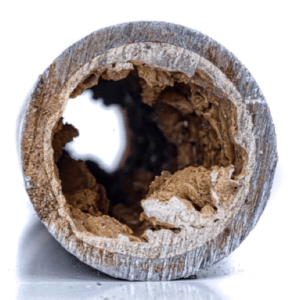
Because improper installation has such a high potential for materially negative consequences for the property owner, it is critical to determine whether the installation has met the manufacturer’s standards before the contractor leaves the site. As such, the following six recommendations6 provided by Dan Robles, PE from Community Engineering Services, PLLC should be considered when evaluating epoxy liner solutions for potable water system renewal:
- Perform a condition assessment to determine remaining material at pitting and threaded areas. Epoxy does not provide any structural reinforcement of the pipe.
- Review the quality manuals of the contractor for compliance with the governing documents for epoxy liner application.
- Enforce, record, and document the testing and inspection at time of application and reconcile with ASTM standards.
- Perform random destructive testing near completion of the project when the contractor is still on site to repair the test section. Consider re-testing near the end of the warranty period.
- Identify, in writing, the contingency plan should any test or inspection fail at time of commissioning, or should a failure occur over the life of the warranty period.
- Assure that contractor warranty matches the epoxy manufacturer’s warranty.
The epoxy material must only be applied by authorized applicators (people – not companies) trained by the epoxy manufacturer. Clients should ask for written documentation from the manufacturer that every person on the job has been suitably trained and is in fact an authorized applicator of their epoxy. Plumbing licensure does not suffice in this regard. If the epoxy is applied by non-authorized applicators, the quality of the application becomes an immediate concern because a poor application could result in varying degrees of failure. Further, we are not aware of any epoxy manufacturers that will honor a warranty of applications applied by non-authorized applicators.
Pipe Sanding/Cleaning
There are two primary concerns with this critical stage of the lining process: surface preparation and potential “blow-outs” during the cleaning process. Before the cleaning process even begins, “existing piping or rigid tubes must be in good condition, with any cracks or leaks or visible signs of corrosion repaired.” 7
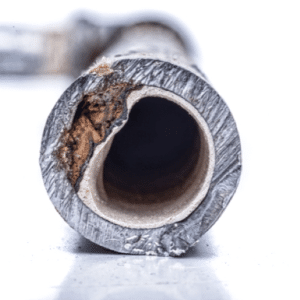
Surface Preparation: If the sanding/cleaning and pipe prep process is not sufficiently completed to the National Association of Corrosion Engineers specifications, the lining may be susceptible to failure. Obtaining that standard of preparation is extremely difficult in complex domestic piping systems. “The abraded pipe, when viewed without magnification, should be free of all visible oil, grease, dirt, mill scale, and loose rust, prepared to a minimum NACE #3 Standard.”8 If the pipe is not sufficiently prepared, there is no way to know if they meet the NACE standard without a video inspection, corrosion can return and grow under the epoxy (between the lining and the pipe wall) pushing the epoxy back into the pipe. This decreases the diameter of the pipe and may ultimately lead to restricted flow and potential perforation or delamination of the lining.
Blowouts: Structurally decayed sections of pipe can rupture during the sanding process.9 Supply pipes must be dried and cleaned before they can be lined with epoxy, and this process creates significant stress on the system, sometimes resulting in further erosion of the pipe wall. The stress of the cleaning process will sometimes cause catastrophic pipe ruptures behind walls at weak points in the piping system. This is of particular concern at spots with existing pinhole leaks, anywhere the pipe wall is compromised, as well as at threaded joints, which are typically weak links in a piping system where corrosion is present. At best, these “blow-outs” require cutting holes in the wall or ceiling and replacing sections of pipe before they can be lined. In worst-case scenarios, properties must abandon the lining solution in favor of a repipe because the pipes are essentially “too far gone” to be lined.
Contingency Planning and Protocols
Some pipe lining projects end up requiring sections of pipe to be replaced. In fact, ASTM standards require any damaged or leaking sections of pipe (including those with pinhole leaks) to be replaced before the epoxy lining process can begin.10 In these instances, the epoxy installer must perform a partial pipe replacement, which raises a series of considerations and questions:
- Does the epoxy installer have documented protocols for opening walls, replacing pipes and communicating with residents?
- Does the epoxy installer have the required licensure to obtain the necessary plumbing and building permits to replace sections of pipe?
- Is the epoxy installer experienced in “fire rated” wall repair?
- Has the epoxy installer obtained the required permits, or will they have to stop work in order to obtain the permits, before the work can continue?
- Does the installer have a contractual obligation to provide protective plastic sheeting and daily clean up to mitigate drywall dust?
- Will the installer guarantee that water supply will be restored every night and on weekends?
- What is the warranty on pipe replacement work?
- Has the building been certified to be free of ACMs and lead? As noted above, walls cannot safely or legally be opened until such certification is obtained. If ACMs or lead are found to be present, the walls must be opened under EPA approved containment procedures performed by a licensed hazardous materials remediation contractor. Epoxy lining contractors may not be aware of this and may not be prepared to coordinate hazardous materials situations.
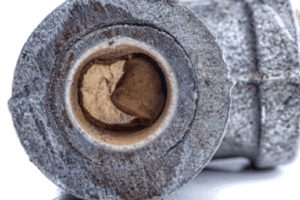
If a property installing pipe lining ends up with significant sections of piping that requires replacement as a result of the epoxy installation process, an epoxy project could easily end up being more invasive, take longer to complete, and be more expensive than a standard repipe.
Cure Time
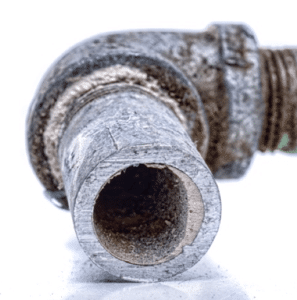
Commonly advertised cure times can range from two to 48 hours. Be sure to ask the installer about the required cure time to get a safe and successful result. “If the mixing and preparation of the [epoxy] coating prior to spraying is not performed correctly within fairly narrow and sometimes unforgiving boundaries, the applied lining can be physically and/or chemically compromised.”11 It’s important to note that historically, epoxy pipe lining started in the naval shipping industry, and was used to line piping in ships that were in dry dock. Original resins had cure times of up to a week, or longer. Even though the resin formulas have been adapted over the years, some resins may have cure times that require the water to be shut off overnight, impacting residents and the ability of the property to remain occupied. In addition, when it is known that the cure times are lengthy, some installers will develop complex temporary bypass systems in an effort to provide water during nights and weekends. However, these systems (which may involve hoses running throughout the property and through units) can be a major potential inconvenience, or worse, a potential trip-and-fall hazard, for residents and maintenance staff.
In some circumstances, the epoxy may not cure properly, and in fact may fail, if exposed to water before it is fully cured. Environmental conditions can vary from building to building, and different installers may require different amounts of time based on the type of epoxy they are using, complexity of the building piping system, their experience, interruptions, etc. This can all mean that, depending on unforeseen variables, installers may not be able to guarantee a return of service time, leaving the property without water overnight, or potentially longer, without advance notice to residents.
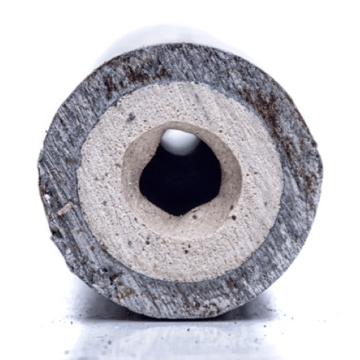
Pipe Run Complexity
Whether blown-in or spin cast, the biggest challenge with installing epoxy lining solutions is when there is a bend in the pipe. The nature of the cleaning process makes it more difficult to ensure the pipe is properly cleaned and prepared on the downstream side of turns in the pipe. Likewise because the airflow around corners such as tees or elbows varies from the inside to the outside of the turn, achieving an even coating of epoxy can be more difficult in these areas. The more turns in a pipe run, the harder it may be to get a uniform coating of epoxy.
Bends in the “pipe run” can slow and complicate a lining solution by requiring additional access points to facilitate lining the various pipe runs properly. Depending on the complexity of the piping system, the installer could end up cutting nearly as many holes as are required for a repipe.
Epoxy Lining Conclusions
The overwhelming amount of risk associated with epoxy lining, coupled with observations of failed installations and their consequences, has led the authors to conclude that epoxy lining pipes within the building envelope is not a comparable alternative to pipe replacement. Before making an investment decision, it is always advisable for a community to explore all its options, including a repipe, to ensure their property is making the most informed decision possible about fixing its leaking pipes.




